The Progress of Sustainable Management of Ammonia Emissions from Agriculture in European Union States Including Poland—Variation, Trends, and Economic Conditions
Abstract
1. Introduction
2. Theory and Background
- cause a loss of nitrogen in animal faeces and mineral nitrogen fertilisers,
- contribute to the eutrophication, or over-nutrification, of the marine environment,
- contributes to the formation of acid rain, which is a threat to natural terrestrial and aquatic ecosystems,
- has a negative impact on human health,
- accelerates corrosion of metal structures and sandstone buildings.
3. Purpose of the Article, Hypothesis, and Materials and Methods
4. Results
5. Discussion
6. Conclusions
Author Contributions
Funding
Institutional Review Board Statement
Informed Consent Statement
Data Availability Statement
Conflicts of Interest
References
- World Meteorological Organization. Statement on the State of the Global Climate in 2019; WMO-No. 1248; World Meteorological Organization: Geneva, Switzerland, 2020; Available online: https://library.wmo.int/ doc_num.php?explnum_id=10211 (accessed on 4 November 2020).
- European State of Climate (ESOTC). European Commission, Copernicus, ECMWF. 2019. Available online: https://climate.copernicus.eu/ESOTC/2019 (accessed on 4 November 2020).
- Storch, H.; Omstedt, A.; Pawlak, J.; Reckermann, M. Second Assessment of Climate Change for the Baltic Sea Basin. Introduction and Summary. In Regional Climate Studies; Bolle, H.-J., Menenti, M., Vesuvio, S.S., Rasool, S.I., Eds.; Springer: Cham, Switzerland, 2015; p. 16. [Google Scholar]
- Murawska, A. Tendencje zmian wzorców konsumpcji w krajach Unii Europejskiej w kierunku zrównoważonego rozwoju (Trends in Consumption Patterns in European Union Countries Towards Sustainable Development). J. Agribus. Rural Dev. 2015, 3, 477–485. [Google Scholar] [CrossRef]
- Murawska, A. Marnowanie Żywności—Wspólny Problem (Food Waste—A Common Problem). Format 2.0; Magazyn Uniwersytetu Technologiczno-Przyrodniczego w Bydgoszczy: Bydgoszcz, Poland, 2019; pp. 26–29. [Google Scholar]
- Głodowska, M.; Gałązka, A. Intensyfikacja rolnictwa a środowisko naturalne (Unsustainable agriculture and its environmental consequences). Zesz. Probl. Postępów Nauk Rol. 2018, 592, 3–13. [Google Scholar] [CrossRef]
- Jadczyszyn, T.; Kopiński, J. Produkcyjne i Środowiskowe Aspekty Nawożenia Azotem (Production and Environmental Aspects of Nitrogen Fertilization); Studia i Raporty; IUNG-PIB (Institute of Soil Science and Plant Cultivation State Research Institute): Puławy, Poland, 2013; Volume 34, pp. 27–45. [Google Scholar]
- Rolnictwo w 2018 r. (Agriculture in 2018); Główny Urząd Statystyczny: Warszawa, Poland, 2019; pp. 17–69. Available online: https://stat.gov.pl/obszary-tematyczne/rolnictwo-lesnictwo/rolnictwo/rolnictwo-w-2018-roku,3,15.html (accessed on 4 November 2020).
- Tian, H.; Xu, R.; Canadell, J.G.; Thompson, R.L.; Winiwarter, W.; Suntharalingam, P.; Yao, Y. A comprehensive quantification of global nitrous oxide sources and sinks. Nature 2020, 586, 248–256. [Google Scholar] [CrossRef] [PubMed]
- Schläpfer, F. External Costs of Agriculture Derived from Payments for Agri-Environment Measures: Framework and Application to Switzerland. Sustainability 2020, 12, 6126. [Google Scholar] [CrossRef]
- Rolnictwo i Gospodarka Żywnościowa w Polsce (Agriculture and Food Economy in Poland). Praca Zbiorowa Pod Red. IERiGŻ; Ministerstwo Rolnictwa i Rozwoju Wsi: Warszawa, Poland, 2019; p. 22. Available online: https://www.gov.pl/web/rolnictwo/rolnictwo-i-gospodarka-zywnosciowa-w-polsce (accessed on 4 November 2020).
- Connelly, N.G.; Damhus, T.; Hartshorn, R.M.; Hutton, A.T. Nomenclature of Inorganic Chemistry; IUPAC Recommendations 2005 (Red Book); International Union of Pure and Applied Chemistry; RSC Publishing: Cambridge, UK, 2005; p. 314. [Google Scholar]
- Pietrzak, S. Dobre Praktyki w Zakresie Ograniczania Emisji Amoniaku z Nawozów (Good Practices for Reducing Ammonia Emissions from Fertilizers); Instytut Melioracji i Użytków Zielonych w Falentach, Zakład Ochrony Jakości Wody: Falenty, Poland, 2009; pp. 1–17. [Google Scholar]
- Marcinkowski, T. Emisja gazowych związków azotu z rolnictwa (The emission of gaseous nitrogen compounds from agriculture). Woda Środowisko Obszary Wiejskie 2010, 10, 175–189. [Google Scholar]
- Faber, A.; Jarosz, Z.; Żyłowski, T. Verification of the Possibilities to Reduce Ammonia Emission for Various Slurry Application Practices in Poland. Probl. World Agric. 2019, 19, 31–40. [Google Scholar] [CrossRef]
- Eurostat. Your Key to European Statistics. 2020. Available online: https://ec.europa.eu/eurostat/data/database (accessed on 30 October 2020).
- Sapek, A. Emisja amoniaku z rolnictwa w Polsce (Emission of ammonia from agriculture in Poland). Zagadnienia Ekonomiki Rolnej 2013, 2, 114–123. [Google Scholar]
- Krajowy Bilans Emisji SO2, NOX, CO, NH3, NMLZO, Pyłów, Metali Ciężkich i TZO za Lata 2015–2017 w Układzie Klasyfikacji SNAP. Raport Syntetyczny (National Emission Balance of SO2, NOX, CO, NH3, NMLZO, Dust, Heavy Metals and TZO for 2015–2017 in the SNAP Classification System. Synthetic Report); Krajowy Ośrodek Bilansowania i Zarządzania Emisjami (KOBIZE) Instytut Ochrony Środowiska—Państwowy Instytut Badawczy (IOŚ-PIB): Warszawa, Poland, 2019; p. 11. Available online: https://www.kobize.pl/uploads/materialy/materialy_do_ pobrania/krajowa_inwentaryzacja_emisji/Bilans_emisji_za_2017.pdf (accessed on 6 November 2020).
- Ni, J.-Q.; Cortus, E.L.; Heber, A.J. Improving Ammonia Emission Modeling and Inventories by Data Mining and Intelligent Interpretation of the National Air Emission Monitoring Study Database. Atmosphere 2011, 2, 110–128. [Google Scholar] [CrossRef]
- Marcinkowski, T.; Kierończyk, M. Emisja amoniaku z wybranych nawozów naturalnych i mineralnych (Ammonia emission from selected organic natural and mineral fertilizers). Zeszyty Problemowe Postępów Nauk Rolniczych 2006, 2, 411–417. [Google Scholar]
- Mielcarek, P. Weryfikacja wartości współczynników emisji amoniaku i gazów cieplarnianych z produkcji zwierzęcej (Verification of emission coefficients of ammonia and greenhouse gases from livestock production). Inżynieria Rolnicza 2012, 4, 267–276. [Google Scholar]
- Kodeks Doradczy Dobrej Praktyki Rolniczej Dotyczący Ograniczenia EMISJI Amoniaku (Advisory Code of Good Agricultural Practice for Reducing Ammonia Emissions); ITP (Institute of Technology and Life Sciences) in Falenty, Ed.; Ministerstwo Rolnictwa i Rozwoju Wsi: Warszawa, Poland, 2019; pp. 9, 13–75. Available online: https://www.gov.pl/attachment/4d85f4d1-65f7-4734-a80f-816d2bafbe73 (accessed on 9 November 2020).
- Liu, Z.; Liu, Y.; Murphy, J.P.; Maghirang, R. Ammonia and Methane Emission Factors from Cattle Operations Expressed as Losses of Dietary Nutrients or Energy. Agriculture 2017, 7, 16. [Google Scholar] [CrossRef]
- Sepperer, T.; Tondi, G.; Petutschnigg, A.; Young, T.M.; Steiner, K. Mitigation of Ammonia Emissions from Cattle Manure Slurry by Tannins and Tannin-Based Polymers. Biomolecules 2020, 10, 581. [Google Scholar] [CrossRef] [PubMed]
- Pietrzak, S. Metoda inwentaryzacji emisji amoniaku ze źródeł rolniczych w Polsce i jej praktyczne zastosowanie (Inventory method for ammonia emissions from agricultural sources in Poland and its practical application). Woda Środowisko Obszary Wiejskie 2006, 6, 319–334. [Google Scholar]
- Kuczyński, T.; Dämmgen, U.; Klimont, Z.; Kres-Tomczak, K.; Myczko, A.; Słobodzian-Ksenicz, O. Ammonia emissions in Poland: Inventory projections, uncertainties. In Emissions from European Agriculture; Kuczyński, T., Dämmgen, U., Webb, J., Myczko, A., Eds.; Wageningen Academic Publishers: Wageningen, The Netherlands, 2005; pp. 217–230. [Google Scholar] [CrossRef]
- Chadwick, D.R. Emissions of ammonia, nitrous oxide and methane from cattle manure heaps: Effect of compaction and covering. Atmos. Environ. 2005, 39, 787–799. [Google Scholar] [CrossRef]
- Kierończyk, M.; Marcinkowski, T. Gospodarstwo rolne jako źródło emisji amoniaku (The farms as a main source of ammonia in the atmosphere). J. Civil Eng. Environ. Archit. JCEEA 2015, 62, 233–241. [Google Scholar]
- Hutchings, N.J.; Sommer, S.G.; Andersen, J.M.; Asman, W.A.H. A detailed ammonia emission inventory for Denmark. Atmos. Environ. 2001, 35, 1959–1968. [Google Scholar] [CrossRef]
- Sapek, A. Emisja amoniaku z produkcji rolnej (Emission of ammonia from agricultural production). Postępy Nauk Rolniczych 1995, 2, 3–23. [Google Scholar]
- Kierończyk, M. Analiza wybranych czynników kształtujących emisję amoniaku podczas przechowywania obornika w warunkach eksploatacyjnych (Analysis of selected factors affecting ammonia emission during storage of farmyard manure under exploitation conditions). Woda Środowisko Obszary Wiejskie 2012, 12, 93–102. [Google Scholar]
- Jugowar, J.L.; Mielcarek, P.; Rzeźnik, W. Niskoemisyjne techniki aplikacji nawozów naturalnych (Low-emission techniques for the application of natural fertilizers). In Kodeks Doradczy Dobrej Praktyki Rolniczej Dotyczący Ograniczenia Emisji Amoniaku (Advisory Code of Good Agricultural Practice for Reducing Ammonia Emissions); ITP (Institute of Technology and Life Sciences) in Falenty, Ed.; Ministerstwo Rolnictwa i Rozwoju Wsi: Warszawa, Poland, 2019; pp. 53–64. Available online: https://www.gov.pl/attachment/4d85f4d1-65f7-4734-a80f-816d2bafbe73 (accessed on 9 November 2020).
- Baltic Slurry Acidification. Interreg Baltic Sea Region. European Regional Development Fund; European Union: Maastricht, The Netherlands; Available online: http://balticslurry.eu/ (accessed on 9 November 2020).
- European Union. Slurry Acidification Has Wide Benefits. Policy Brief. Baltic Slurry Acidification. Interreg Baltic Sea Region. European Regional Development Fund. Available online: http://balticslurry.eu/wp-content/uploads/2017/01/Policy-Brief-Benefits.pdf (accessed on 9 November 2020).
- Birkmose, T.; Vestergaard, A. Acidification of slurry in barns, stores and during application: Review of Danish research, trials and experience. In Proceedings of the 15th Ramiran Conference, Versailles, France, 10–13 June 2013. [Google Scholar]
- Kai, P.; Pedersen, P.; Jensen, J.E.; Hansen, M.N.; Sommer, S.G. A whole-farm assessment of the efficacy of slurry acidification in reducing ammonia emissions. Eur. J. Agron. 2008, 28, 148–154. [Google Scholar] [CrossRef]
- Kierończyk, M.; Mazur, K.; Barwicki, J.; Wiśniewska, R.; Fligiel, B. Report of Institute of Technology and Life Sciences. Results of ammonia emission in 2017 during field trials on permanent grassland. Final Report of Activity WP4 Field Trials: Methodology, Collection of Results and Partners’ Practical Experiences 2016–2018. Available online: http://balticslurry.eu/wp-content/uploads/2016/06/Report-WP4.pdf (accessed on 9 November 2020).
- Jarosz, Z.; Faber, A. Ograniczenie emisji amoniaku podczas stosowania nawozów mineralnych (Reduction of ammonia emissions when using mineral fertilizers). In Kodeks Doradczy Dobrej praktyki Rolniczej Dotyczący Ograniczenia Emisji Amoniaku (Advisory Code of Good Agricultural Practice for Reducing Ammonia Emissions); ITP (Institute of Technology and Life Sciences) in Falenty, Ed.; Ministerstwo Rolnictwa i Rozwoju Wsi: Warszawa, Poland, 2019; pp. 65–74. [Google Scholar]
- Skowrońska, M. Straty Amoniaku z Mocznika (Loss of Ammonia from Urea). 2016. Available online: https://nawozy.eu/wiedza/porady-ekspertow/rosliny/straty-amoniaku-z-mocznika.html (accessed on 11 November 2020).
- Zaliwski, S. Emisja Gazów Cieplarnianych Przez Rolnictwo (Greenhouse Gas Emissions from Agriculture); Studia i Raporty IUNG-PIB (Institute of Soil Science and Plant Cultivation State Research Institute): Puławy, Poland, 2007; pp. 35–47. [Google Scholar] [CrossRef]
- Bittman, S.; Dedina, M.; Howard, C.M.; Oenema, O.; Sutton, M. (Eds.) Options for Ammonia Mitigation: Guidance from the UNECE Task Force on Reactive Nitrogen; Centre for Ecology & Hydrology (CEH): Edinburgh, UK, 2014; Available online: http://nora.nerc.ac.uk/id/eprint/510206/1/N510206CR.pdf (accessed on 9 November 2020).
- Bieńkowski, J. Regionalne zróżnicowanie emisji amoniaku w polskim rolnictwie w latach 2005-2007 (Regional differentiation of ammonia emission in Polish agriculture in the years 2005–2007). Fragm. Agron. 2010, 27, 21–31. [Google Scholar]
- Siggia, D.; Lasorella, M.V.; Kolte, A.; Rossi, M.; Pawar, A. Performance orientation towords biodiversity impacts of energy crop production on agricultural land use and farmland habitats in Europe. J. Crit. Rev. 2020, 7, 1–6. [Google Scholar] [CrossRef]
- Siggia, D.; Lasorella, M.V.; Kolte, A.; Pawar, A. Management of energy production with thermochemical combustion: The case of switchgrass perennial crop in mediterranean environment. J. Crit. Rev. 2020, 7, 1185–1192. [Google Scholar] [CrossRef]
- Convention on Long-Range Transboundary Air Pollution. Geneva 1979. Available online: https://www.unece.org/env/lrtap/welcome.html.html (accessed on 18 November 2020).
- Directive NEC. Directive (EU) 2016/2284 of the European Parliament and of the Council of 14 December 2016 on the Reduction of National Emissions of Certain Atmospheric Pollutants, Amending Directive 2003/35/EC and Repealing Directive 2001/81/EC (Text with EEA Relevance). Available online: https://eur-lex.europa.eu/legal-content/EN/TXT/?uri=CELEX%3A32016L2284 (accessed on 4 November 2020).
- Commission Implementing Decision (EU) 2017/302 of 15 February 2017 Establishing Best Available Techniques (BAT) Conclusions, under Directive 2010/75/EU of the European Parliament and of the Council, for the Intensive Rearing of Poultry or Pigs. Available online: https://eur-lex.europa.eu/legal-content/EN/TXT/?uri=uriserv:OJ.L_.2017.043.01.0231.01.ENG&toc=OJ:L:2017:043:FULL (accessed on 4 November 2020).
- Commission Implementing Decision (EU) 2018/1522 of 11 October 2018 Laying Down a Common Format for National Air Pollution Control Programmes under Directive (EU) 2016/2284 of the European Parliament and of the Council on the Reduction of National Emissions of Certain Atmospheric Pollutants. Available online: https://eur-lex.europa.eu/legal-content/EN/ALL/?uri=CELEX%3A02018D1522-20181012 (accessed on 4 November 2020).
- IUNG-PIB (Institute of Soil Science and Plant Cultivation State Research Institute) in Puławy. Zbiór Zaleceń Dobrej Praktyki Rolniczej Mający na Celu Ochronę Wód Przed Zanieczyszczeniem Azotanami Pochodzącymi ze Źródeł Rolniczych (A Collection of Good Agricultural Practice Recommendations Aimed at Protecting Waters against Pollution with Nitrates from Agricultural Sources); Ministerstwo Rolnictwa i Rozwoju Wsi: Warszawa, Poland, 2019. Available online: https://sir.cdr.gov.pl/2019/10/16/kodeks-amoniakowy-oraz-zbior-zalecen-dobrej-praktyki-rolniczej-majacej-na-celu-ochrone-wod-przez-zanieczyszeniami-azotanami/zbior_zalecen_dobrej_praktyki_rolniczej_26022019_egz_bip/ (accessed on 6 November 2020).
- Rozporządzenie Rady Ministrów z Dnia 5 Czerwca 2018 r. w Sprawie Przyjęcia “Programu Działań Mających na Celu Zmniejszenie Zanieczyszczenia Wód Azotanami Pochodzącymi ze Źródeł Rolniczych Oraz Zapobieganie Dalszemu Zanieczyszczeniu” (Regulation of the Council of Ministers of 5 June 2018 on the Adoption of the “Action Program to Reduce Water Pollution with Nitrates from Agricultural Sources and to Prevent Further Pollution”). Dz. U. 2018, poz. 1339. Available online: https://isap.sejm.gov.pl/isap.nsf/DocDetails.xsp?id=WDU20180001339 (accessed on 4 November 2020).
- ZAŁĄCZNIK. Wspólny Format Krajowego Programu Ograniczania Zanieczyszczenia Powietrza na Podstawie Art. 6 Dyrektywy (UE) 2016/2284, Krajowy Program Ograniczania Zanieczyszczenia Powietrza (ANNEX Common format for a National Air Pollution Control Program Pursuant to Art. 6 of Directive (EU) 2016/2284, the National Air Pollution Control Program), 2019. Available online: https://ec.europa.eu/environment/air/pdf/reduction_napcp/PL%20final%20NAPCP%2027Jun19%20annexed%20report.pdf (accessed on 4 November 2020).
- International Organization for Standardization. ISO. 2019. Country Codes—ISO 3166. Available online: https://www.iso.org/iso-3166-country-codes.html (accessed on 10 November 2020).
- Wysocki, F.; Lira, J. Statystyka Opisowa (Descriptive Statistics); Wydawnictwo Akademii Rolniczej im. Augusta Cieszkowskiego: Poznań, Poland, 2005. [Google Scholar]
- Luszniewicz, A.; Słaby, T. Statystyka z Pakietem Komputerowym STATISTICA PL. Teoria i Zastosowania (Statistics with the STATISTICA PL Computer Package. Theory and Applications); Wydawnictwo, C.H., Ed.; Beck: Warszawa, Poland, 2003. [Google Scholar]
- European Environment Agency. EEA 2020. Available online: https://europa.eu/european-union/about-eu/agencies/eea_en (accessed on 10 November 2020).
- Zrównoważony Rozwój i Cele Zrównoważonego Rozwoju (Sustainable Development and Sustainable Development Goals); UNIC: Warszawa, Poland, 2015. Available online: http://www.unic.un.org.pl/strony-2011-2015/zrownowazony-rozwoj-i-cele-zrownowazonego-rozwoju/2860 (accessed on 10 November 2020).
- Kopeć, E. Regulacje Unii Europejskiej a wskaźniki gospodarki o obiegu zamkniętym w Polsce (European Union regulations and indicators of the circular economy in Poland). In Wskaźniki Monitorowania Gospodarki o Obiegu Zamkniętym (Circular Economy Monitoring Indicators); Kulczycka, J., Ed.; Instytut Gospodarki Surowcami Mineralnymi i Energią Polskiej Akademii Nauk IGSMiE PAN: Kraków, Poland, 2020; pp. 21–35. [Google Scholar]
- Kulczycka, J. (Ed.) Wskaźniki Monitorowania Gospodarki o Obiegu Zamkniętym (Circular Economy Monitoring Indicators); Instytut Gospodarki Surowcami Mineralnymi i Energią Polskiej Akademii Nauk IGSMiE PAN: Kraków, Poland, 2020. [Google Scholar]
- Kuznets, S. Economic Growth and Income Inequality. Available online: https://assets.aeaweb.org/asset-server/files/9438.pdf (accessed on 10 November 2020).
- Fodha, M.; Zaghdoud, O. Economic growth and pollutant emissions in Tunisia: An empirical analysis of the environmental Kuznets curve. Energy Policy 2010, 38, 1150–1156. [Google Scholar] [CrossRef]
- Ozcan, B. The nexus between carbon emissions, energy consumption and economic growth in Middle East countries: A panel data analysis. Energy Policy 2013, 62, 1138–1147. [Google Scholar] [CrossRef]
- Jovanović, M.; Kašćelan, L.; Despotović, A.; Kašćelan, V. The Impact of Agro-Economic Factors on GHG Emissions: Evidence from European Developing and Advanced Economies. Sustainability 2015, 7, 16290–16310. [Google Scholar] [CrossRef]
- Narayan, P.K.; Narayan, S. Carbon dioxide emissions and economic growth: Panel data evidence from developing countries. Energy Policy 2010, 38, 661–666. [Google Scholar] [CrossRef]
- Wawrzyniak, D. Weryfikacja środowiskowej krzywej Kuznetsa dla krajów Unii Europejskiej. Ekonomista 2018, 3, 318–334. [Google Scholar]
- Hamit-Haggar, M. Greenhouse gas emissions, energy consumption and economic growth: A panel cointegration analysis from Canadian industrial sector perspective. Energy Econ. 2012, 34, 358–364. [Google Scholar] [CrossRef]
- Chen, J.; Liu, Y.J.; Pan, T.; Ciais, P.; Ma, T.; Liu, Y.H.; Yamazaki, D.; Ge, Q.S.; Penuelas, J. Global socioeconomic exposure of heat extremes under climate change. J. Clean. Prod. 2020, 277123275. [Google Scholar] [CrossRef]
- Ziolo, M.; Kluza, K.; Spoz, A. Impact of Sustainable Financial and Economic Development on Greenhouse Gas Emission in the Developed and Converging Economies. Energies 2019, 12, 4514. [Google Scholar] [CrossRef]
- Klepacki, B. Zrównoważony rozwój terenów wiejskich–wybrane aspekty teoretyczne (Sustainable development of rural areas—Selected theoretical aspects). Roczniki Naukowe Stowarzyszenia Ekonomistów Rolnictwa i Agrobiznesu SERiA 2000, 2, 8–13. [Google Scholar]
- Czudec, A.; Miś, T.; Zając, D. Zrównoważony Rozwój Obszarów Wiejskich w Wymiarze Regionalnym (Sustainable Development of Rural Areas in the Regional Dimension); Bogucki Wydawnictwo Naukowe: Poznań, Rzeszów, Poland, 2018; p. 7. [Google Scholar]
- Janiszewska, D.A.; Ossowska, L. Zróżnicowanie rolnictwa krajów Unii Europejskiej na podstawie wybranych cech (Diversification of agriculture in the European Union on the basis of selected features). Zeszyty Naukowe SGGW w Warszawie, Problemy Rolnictwa Światowego 2014, 14, 45–54. [Google Scholar]
- Janiszewska, D.A.; Ossowska, L. Wybrane aspekty oddziaływania rolnictwa na środowisko w państwach Unii Europejskiej (The Impact of Agriculture on the Environment in EU Countries—Selected Aspects). Zeszyty Naukowe SGGW w Warszawie, Problemy Rolnictwa Światowego 2017, 17, 73–83. [Google Scholar] [CrossRef][Green Version]
- Matyka, M. Stan rolnictwa w Polsce na tle Unii Europejskiej (The condition of agriculture in Poland compared to the European Union). In Studia Raporty; IUNG-PIB (Institute of Soil Science and Plant Cultivation State Research Institute): Puławy, Poland, 2014; Volume 40, pp. 9–28. [Google Scholar]
- Mukumbuta, I.; Shimizu, M.; Hatano, R. Mitigating Global Warming Potential and Greenhouse Gas Intensities by Applying Composted Manure in Cornfield: A 3-Year Field Study in an Andosol Soil. Agriculture 2017, 7, 13. [Google Scholar] [CrossRef]
- Communication from the Commission to the European Parliament, the Council, the European Economic and Social Committee and the Committee of the Regions “Stepping up Europe’s 2030 Climate Ambition Investing in a Climate-Neutral Future for the Benefit of Our People”. COM/2020/562 Final. Available online: https://ec.europa.eu/clima/sites/clima/files/eu-climate-action/docs/com_2030_ctp_en.pdf (accessed on 4 November 2020).
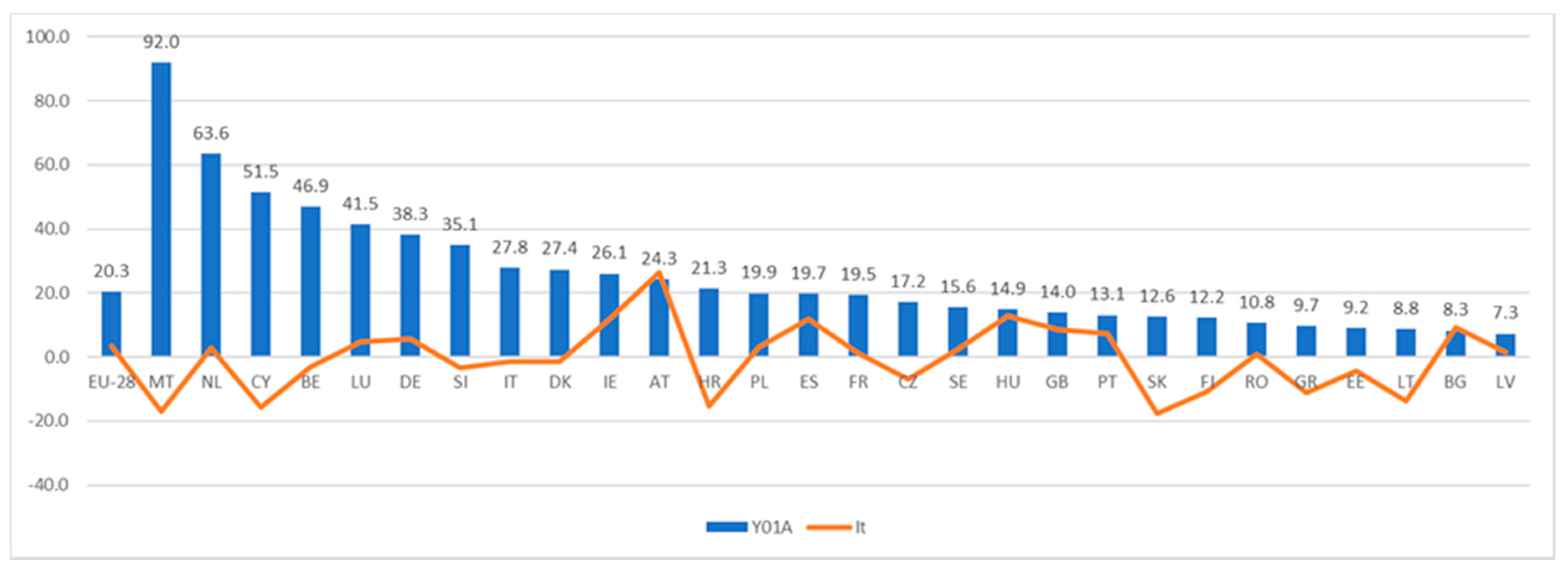
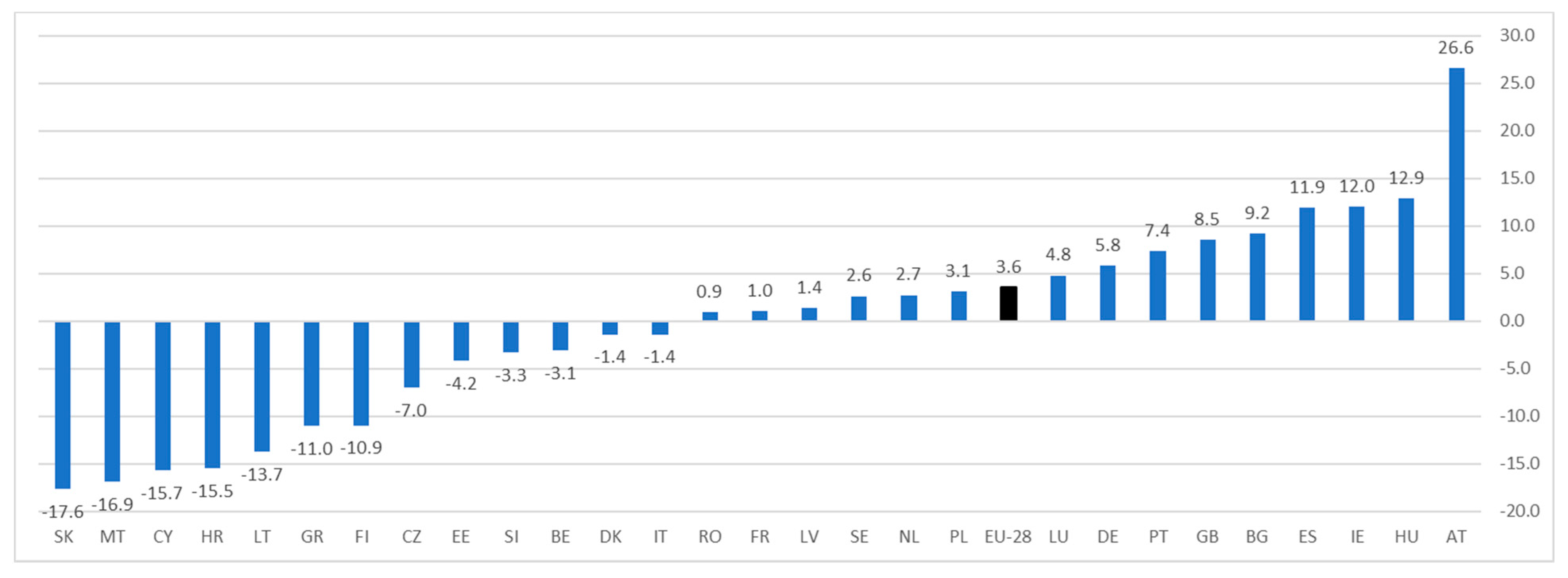
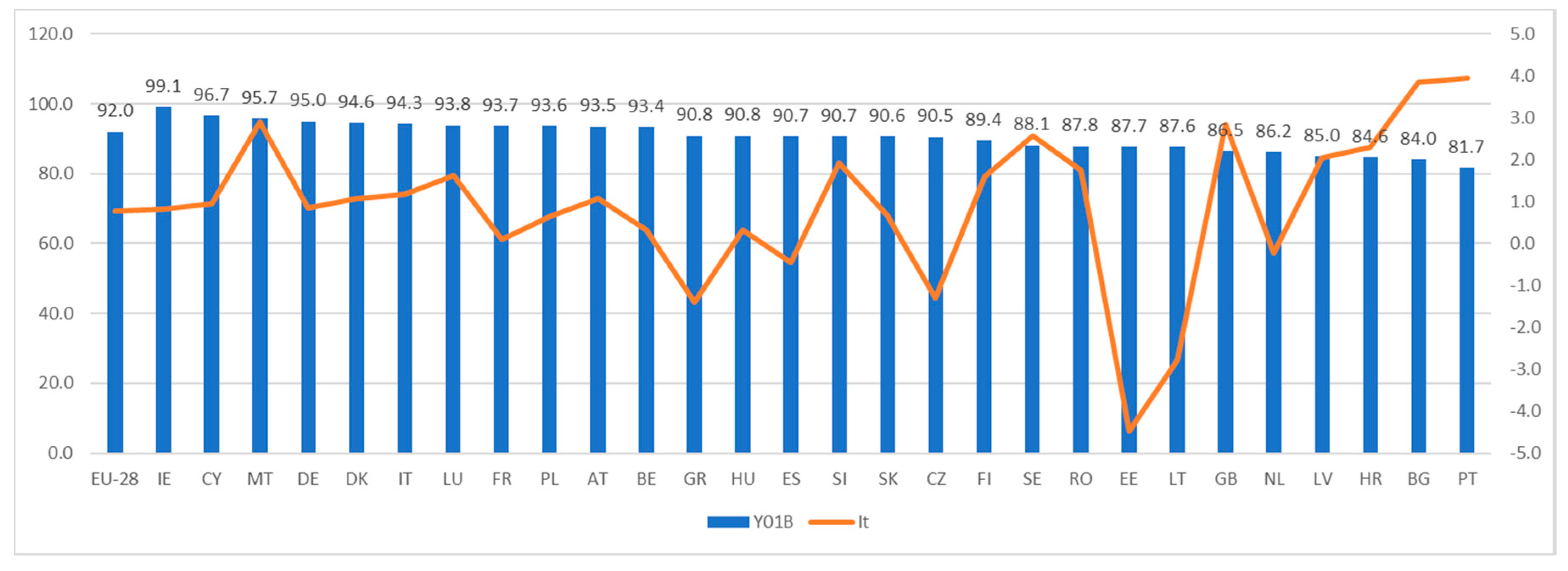
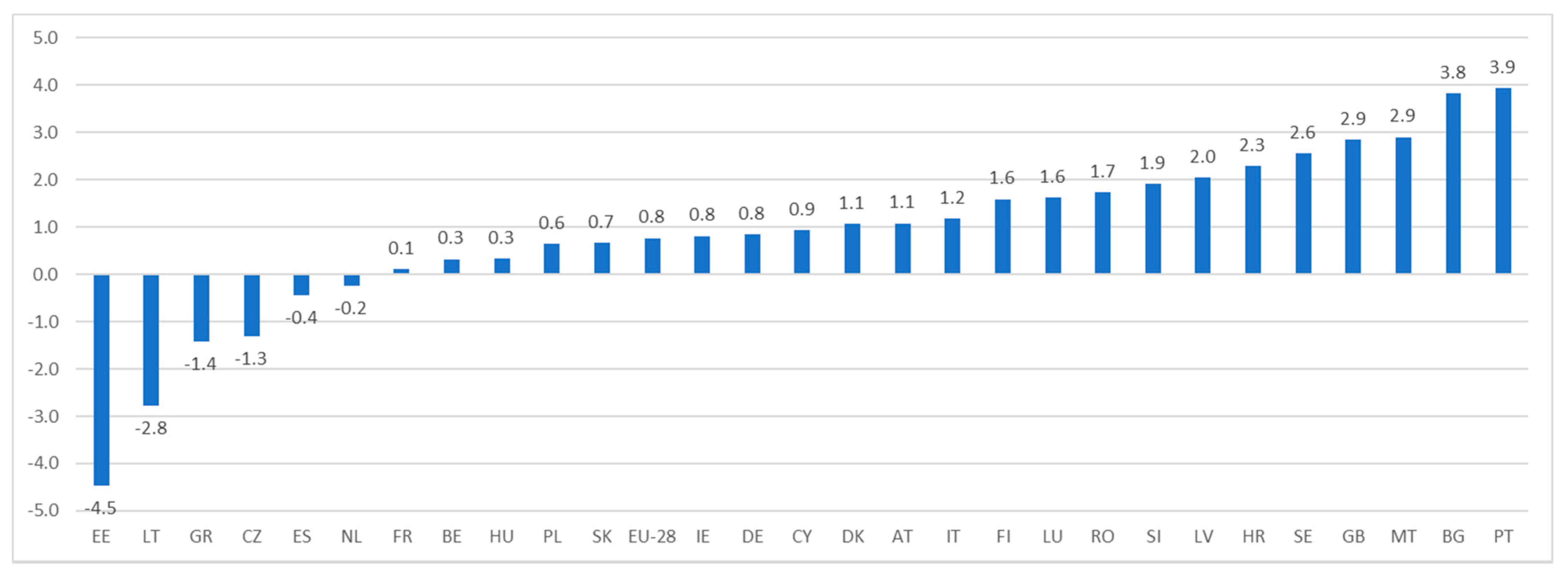
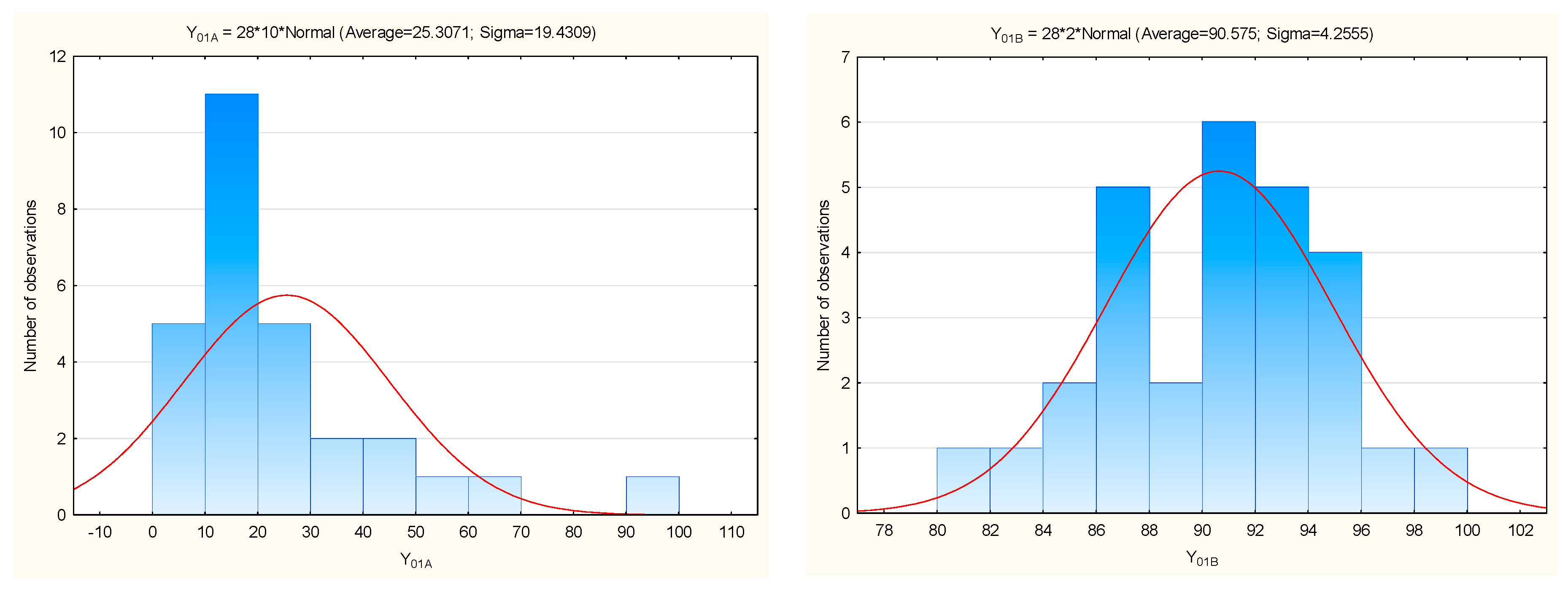
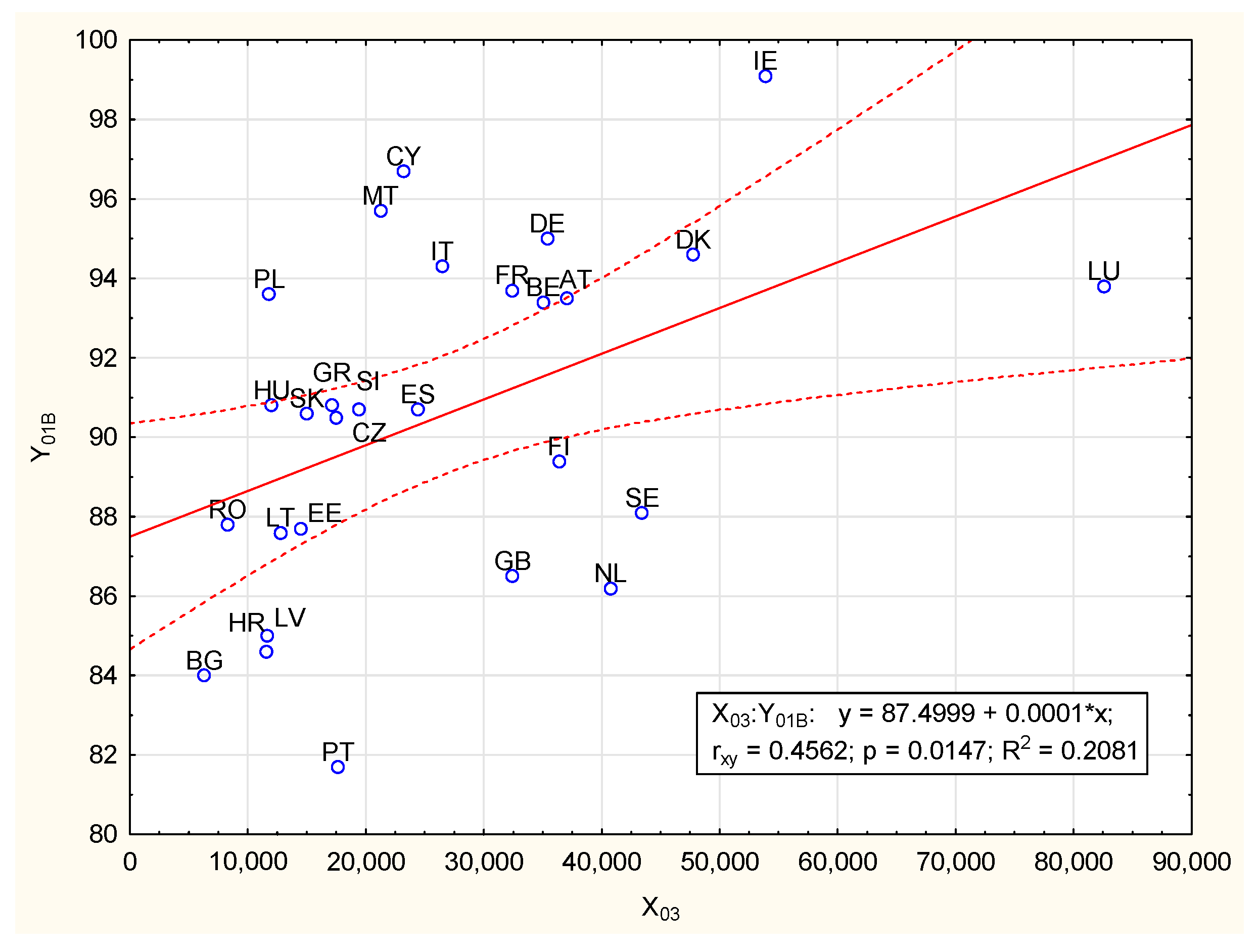
| Variable | Year | Variable Name | Variable Description |
|---|---|---|---|
| Indicators characterising the level of ammonia emissions in agriculture in European Union countries in 2010–2017—the effects of promoting sustainable management of resources in agriculture | |||
| Y01A | 2010–2017 | Ammonia (NH3) emissions from agriculture in kilograms per hectare | The indicator measures ammonia (NH3) emissions as a result of agricultural production. Ammonia emissions per hectare were calculated using the total utilised agricultural area (UAA) of the relevant year as the denominator. |
| Y01B | 2010–2017 | Ammonia (NH3) emissions from agriculture—percentage of total emissions (source: EEA) [55] | The indicator tracks trends in anthropogenic atmospheric emissions of ammonia by agriculture. |
| Indicators characterising economic situations of countries and the level of income earned from agriculture and outlays on research and development in agriculture in European Union countries in 2010–2019 | |||
| X01 | 2010–2019 | Government support for agricultural research and development in EUR per capita | The indicator refers to government appropriations or outlays on research and development (R&D). |
| X02 | 2010–2018 | Agricultural factor income in EUR per annual work unit (AWU) | The indicator is a partial labour productivity measure of the agricultural sector. Agricultural factor income measures the income generated by farming, which is used to remunerate borrowed or rented factors of production (capital, wages, and land rents) as well as own production factors (own labour, capital, and land). |
| X03 | 2010–2019 | Real GDP per capita in EUR | The indicator is calculated as the ratio of real GDP to the average population of a specific year. GDP measures the value of total final output of goods and services produced by an economy within a certain period of time. |
| Ammonia (NH3) Emissions from Agriculture (in kg/ha) | |||||||||
|---|---|---|---|---|---|---|---|---|---|
| Year | 2010 | 2011 | 2012 | 2013 | 2014 | 2015 | 2016 | 2017 | It2017 (2010 = 100) |
| EU(28) total | 19.6 | 19.7 | 19.7 | 19.7 | 19.9 | 20.1 | 20.3 | 20.3 | 3.6 |
| ymin Latvia LV | 7.2 | 7.1 | 7.2 | 7.3 | 7.5 | 7.4 | 7.2 | 7.3 | 1.4 |
| ymax Malta MT | 110.7 | 99.1 | 100.8 | 100.3 | 99.3 | 98.5 | 94.9 | 92.0 | −16.9 |
| Poland PL | 19.3 | 19.1 | 18.8 | 19.0 | 18.7 | 18.5 | 18.9 | 19.9 | 3.1 |
| Vs | 85.5 | 80.3 | 80.4 | 80.4 | 79.4 | 78.5 | 77.9 | 76.8 | - |
| D | 15.4 | 14.0 | 14.0 | 13.7 | 13.2 | 13.3 | 13.2 | 12.6 | - |
| R | 103.5 | 92.0 | 93.6 | 93.0 | 91.8 | 91.1 | 87.7 | 84.7 | - |
| K1 | 12.7 | 12.9 | 12.6 | 12.4 | 13.0 | 12.7 | 12.7 | 12.5 | - |
| M | 18.9 | 18.6 | 18.4 | 18.7 | 18.7 | 18.7 | 19.0 | 19.6 | - |
| K3 | 30.2 | 30.9 | 31.4 | 30.5 | 29.6 | 29.9 | 30.6 | 29.6 | - |
| As | 2.4 | 2.1 | 2.2 | 2.2 | 2.1 | 2.2 | 2.0 | 1.9 | - |
| K | 6.9 | 5.1 | 6.0 | 5.9 | 5.6 | 6.0 | 4.6 | 4.2 | - |
| Ammonia (NH3) Emissions from Agriculture—% of Total Emissions | |||||||||
|---|---|---|---|---|---|---|---|---|---|
| Year | 2010 | 2011 | 2012 | 2013 | 2014 | 2015 | 2016 | 2017 | It2017 (2010 = 100) |
| EU(28) total | 91.3 | 91.5 | 91.6 | 91.7 | 92.1 | 92.0 | 92.0 | 92.0 | 0.8 |
| yminPortugal PT | 78.6 | 79 | 79.7 | 79.9 | 80.5 | 81.2 | 81.7 | 81.7 | 3.9 |
| ymaxIreland IE | 98.3 | 98.4 | 98.6 | 98.7 | 98.7 | 98.8 | 99.0 | 99.1 | 0.8 |
| Poland PL | 93.0 | 93.1 | 93.1 | 93.2 | 93.5 | 93.5 | 93.5 | 93.6 | 0.6 |
| Vs | 5.3 | 5.3 | 5.2 | 5.0 | 4.8 | 4.6 | 4.6 | 4.7 | - |
| D | 1.3 | 1.2 | 1.2 | 1.2 | 1.2 | 1.2 | 1.2 | 1.2 | - |
| R | 19.7 | 19.4 | 18.9 | 18.8 | 18.2 | 17.6 | 17.3 | 17.4 | - |
| K1 | 86.4 | 86.9 | 86.7 | 87.3 | 87.7 | 88.1 | 87.8 | 87.7 | - |
| M | 91.4 | 90.6 | 91.1 | 91.2 | 91.5 | 90.7 | 90.7 | 90.7 | - |
| K3 | 93.0 | 93.2 | 93.5 | 93.3 | 94.2 | 93.9 | 93.7 | 93.7 | - |
| As | −0.7 | −0.6 | −0.5 | −0.5 | −0.5 | −0.3 | −0.2 | −0.1 | - |
| K | 0.0 | −0.2 | −0.5 | −0.3 | −0.3 | −0.4 | −0.5 | −0.6 | - |
| Variable | Y01A | Y01B | ItY01A | ItY01B |
|---|---|---|---|---|
| Y01A | 1.000 | 0.472 * | −0.194 | 0.157 |
| Y01B | 0.472 * | 1.000 | 0.001 | −0.171 |
| ItY01A | −0.194 | 0.001 | 1.000 | 0.196 |
| ItY01B | 0.157 | −0.171 | 0.196 | 1.000 |
| Variable | X01 | X02 | X03 |
|---|---|---|---|
| X01 | 1.000 | 0.431 * | 0.403 * |
| X02 | 0.431 * | 1.000 | 0.612* |
| X03 | 0.403 * | 0.612 * | 1.000 |
| Variable | X01 | X02 | X03 |
|---|---|---|---|
| Y01A | 0.109 | 0.299 | 0.337 |
| Y01B | 0.467 * | 0.219 | 0.456 * |
| Summary of Dependent Variable Regression: Y01B; rxy = 0.456, R2 = 0.208 Corrected R2= 0.178; F (1.26) = 6.8333, p < 0.0147 Standard Error of Estimation (SEE): 3.859 | ||||||
|---|---|---|---|---|---|---|
| N = 28 | b * | SEE from b * | b | SEE from b | t (26) | p |
| Free word | 87.500 | 1.384 | 63.219 | 0.000 | ||
| X03 | 0.456 | 0.175 | 0.000 | 0.000 | 2.614 | 0.015 |
| Summary of Dependent Variable Regression: Y01B; rxy = 0.574 R2 = 0.329; Corrected R2 = 0.245; F (3.24) = 3.929 p < 0.0205 Standard Error of Estimation (SEE): 3.696 | ||||||
|---|---|---|---|---|---|---|
| N = 28 | b * | SEE from b * | b | SEE from b | t (24) | p |
| Free word | 87.125 | 1.453 | 59.954 | 0.000 | ||
| X01 | 0.384 | 0.189 | 0.337 | 0.166 | 2.033 | 0.053 |
| X02 | −0.209 | 0.219 | 0.000 | 0.000 | −0.958 | 0.348 |
| X03 | 0.430 | 0.216 | 0.000 | 0.000 | 1.993 | 0.058 |
Publisher’s Note: MDPI stays neutral with regard to jurisdictional claims in published maps and institutional affiliations. |
© 2021 by the authors. Licensee MDPI, Basel, Switzerland. This article is an open access article distributed under the terms and conditions of the Creative Commons Attribution (CC BY) license (http://creativecommons.org/licenses/by/4.0/).
Share and Cite
Murawska, A.; Prus, P. The Progress of Sustainable Management of Ammonia Emissions from Agriculture in European Union States Including Poland—Variation, Trends, and Economic Conditions. Sustainability 2021, 13, 1035. https://doi.org/10.3390/su13031035
Murawska A, Prus P. The Progress of Sustainable Management of Ammonia Emissions from Agriculture in European Union States Including Poland—Variation, Trends, and Economic Conditions. Sustainability. 2021; 13(3):1035. https://doi.org/10.3390/su13031035
Chicago/Turabian StyleMurawska, Anna, and Piotr Prus. 2021. "The Progress of Sustainable Management of Ammonia Emissions from Agriculture in European Union States Including Poland—Variation, Trends, and Economic Conditions" Sustainability 13, no. 3: 1035. https://doi.org/10.3390/su13031035
APA StyleMurawska, A., & Prus, P. (2021). The Progress of Sustainable Management of Ammonia Emissions from Agriculture in European Union States Including Poland—Variation, Trends, and Economic Conditions. Sustainability, 13(3), 1035. https://doi.org/10.3390/su13031035






